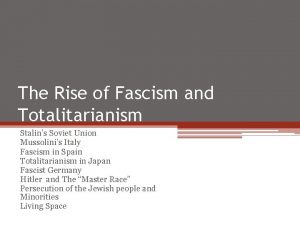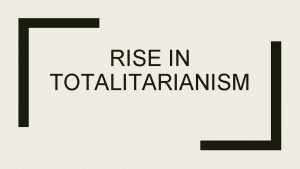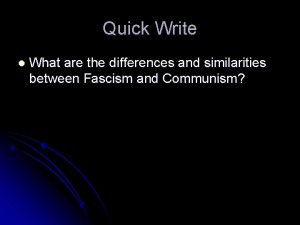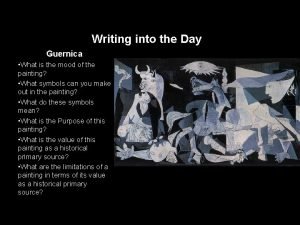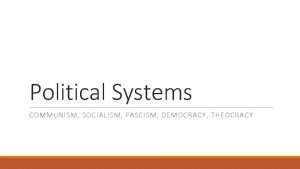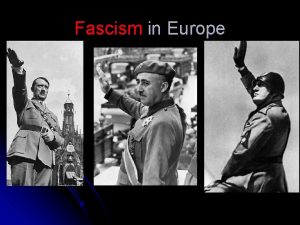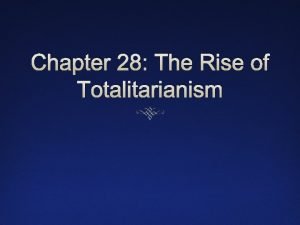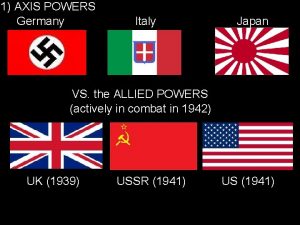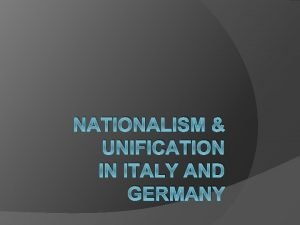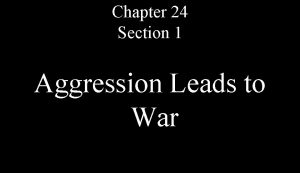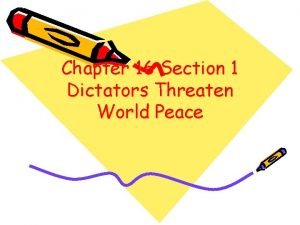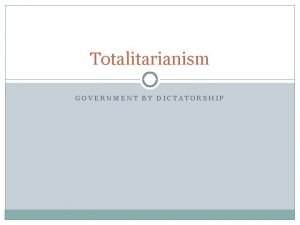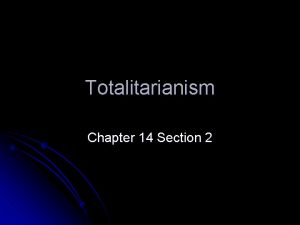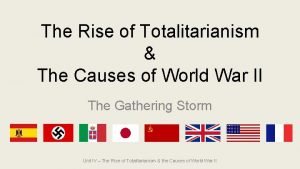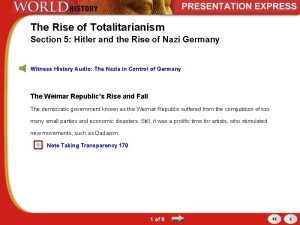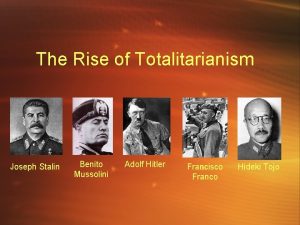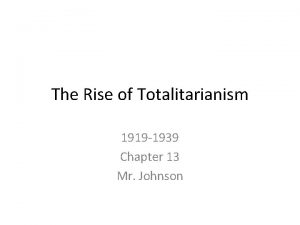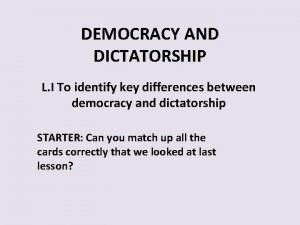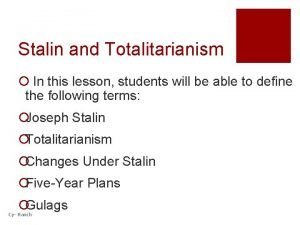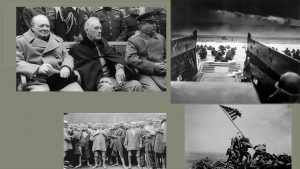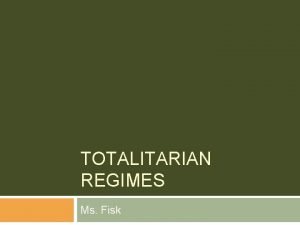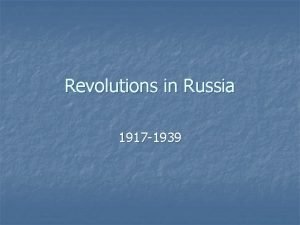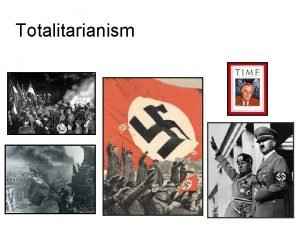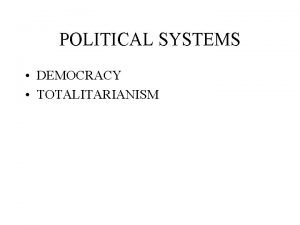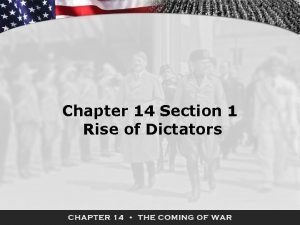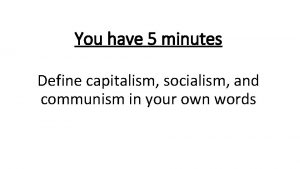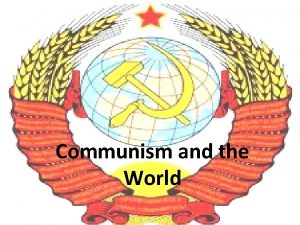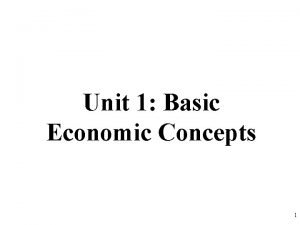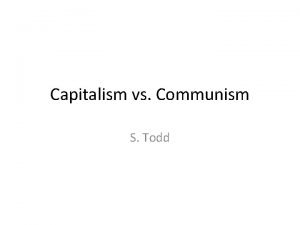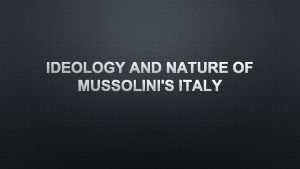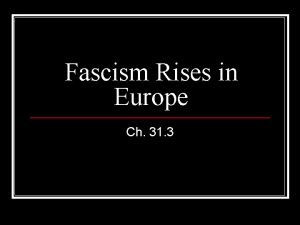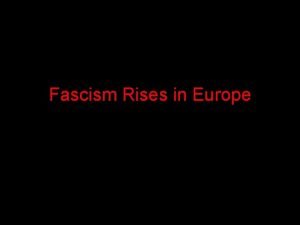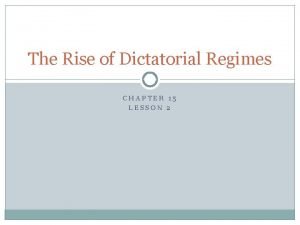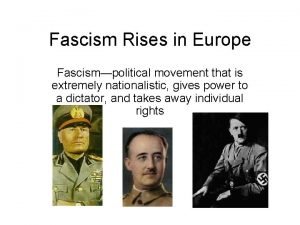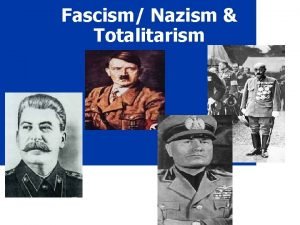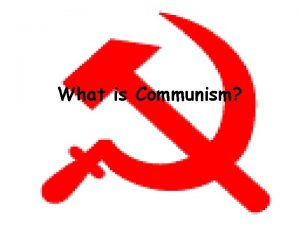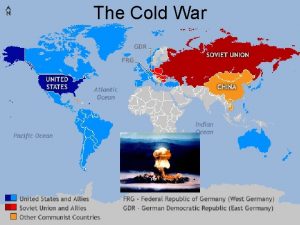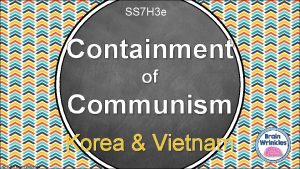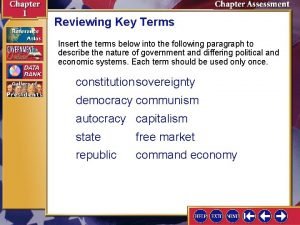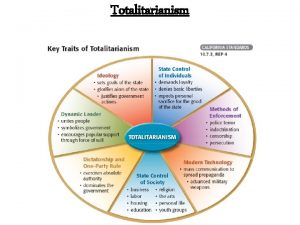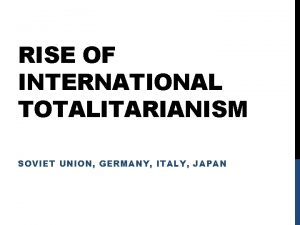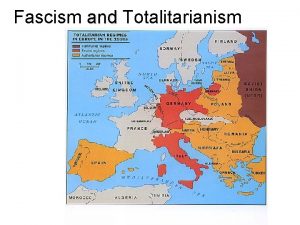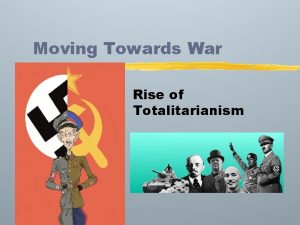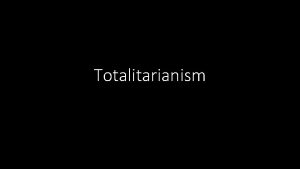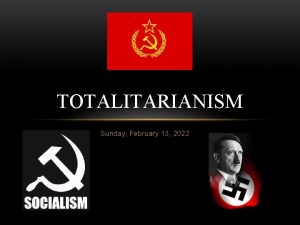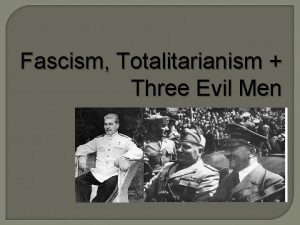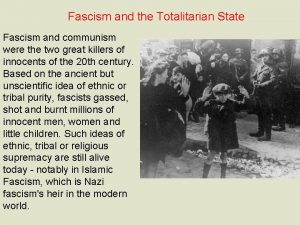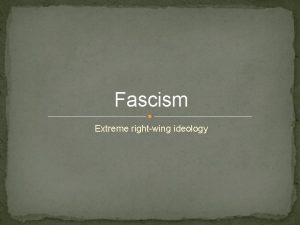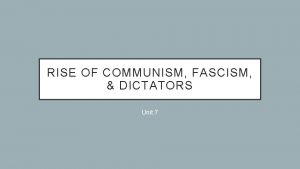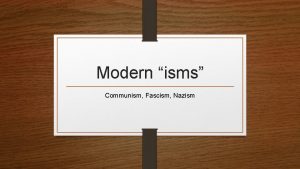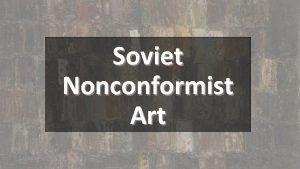Fascism Totalitarianism Communism and Militarists Italy Germany Soviet



























































- Slides: 59

Fascism, Totalitarianism, Communism, and Militarists Italy, Germany, Soviet Union, Japan 1

Fascism • Run by a single strong leader or party which places emphasis on the needs and goals of the state rather than the needs of the individual. • The people serve the state/nation. 9/15/2020 2

What were five factors that led to a Fascist type government? 1. Economic crisis, from the depression. 2. Instead of securing a “just and secure peace, ” The Treaty of Versailles caused anger and resentment. 3. Desire for leadership/order 4. Fear of Communists 5. Fear of social unrest/chaos 9/15/2020 3

Features of Fascism: “People serve the Nation” • National needs override personal freedoms • Single charismatic dictatorial leader • Obedience to the leader and his authority • Visibly patriotic • Rival of past military glory • Strong and visible military • Capitalism based on needs of the state • Supports a class-based society 9/15/2020 4

Name Two Fascist Nations: • Italy • Germany 9/15/2020 5

Fascist Party • Leader: Benito Mussolini • Country: Italy 9/15/2020 6

• Title “The Leader”: Il Duce • Came to Power: 1922 9/15/2020 7

• Ideology: Nationalism State interest placed above individual interests. • Control: Reaction against the communist Government in Russia. – – 9/15/2020 Supported by soldiers and veterans and middle and upper classes People wanted the “glory” and military-style organization the Fascist Party promoted. 8

• Nickname: Blackshirts • Fascist Slogan: – “Believe! Obey! Fight! 9/15/2020 9

Benito Mussolini 9/15/2020 10

Nazi Party • Leader: Adolf Hitler • Country: Germany 9/15/2020 11

• Title “The Leader”: • Der Führer • Came to Power: January 1933 (Hitler established a following in 1923) 9/15/2020 12

9/15/2020 13

Why the third Reich? • The Holy Roman Empire, was considered the First Empire or First Reich. – It lasted almost a thousand years from 843 to 1806. • The German empire under the Hohenzollern dynasty was the Second Reich. – It lasted 47 years from 1871 to 1918 9/15/2020 14

• The Third Reich was the German state under Adolf Hitler – It lasted 12 years from 1933 to 1945. 9/15/2020 15

9/15/2020 Ideology: Anti-communist Anti. Semitic Master Race (German Descent) Control: Appealing to upper and middle classes. v Played on emotions of people; gave the German people someone to blame. v Put people to work: Ø Storm troopers, “Brown Shirts”, Ø Gestapo, “Secret Police”. v Germans overall pleased with Nazi government and economy was on the rise. v Hitler put people to work making military equipment. 16

Nazi Slogans: “Heil Hitler” 9/15/2020 17

Adolph Hitler 9/15/2020 18

Totalitarianism • Totalitarianism: Fascism and Communism introduced the world to a new category of political leaders: totalitarian. • They demanded total control of all aspects of life. 9/15/2020 19

Features of Totalitarianism: (Total control of all aspects of society) Government controlled by one person Mass communication of propaganda for social conditioning of the people Primary goal is to build personal and national power 9/15/2020 20

Demand agreement of an official ideology not just acceptance Use of oppression and terror to eliminate all internal opposition Imposing controls on all aspects of public and private life. 9/15/2020 21

Communism • Run by one strong leader or party in which the means of production (industry) and distribution are controlled by the state. • Private property is eliminated and the government distributes the necessities of life based on equality and need. 9/15/2020 22

Russia created a communist state and waited for a world revolution. • a revolution by workers of Industries • the eventual rule by working class • State ownership of all property 9/16/2020 23

Joseph Stalin Leader of Union of Soviet Socialis Republic (USSR) 9/16/2020 24

Josef Stalin 9/16/2020 25

Russian Culture • Agricultural lands were created into large, state-run farms. • Industrial development increased and production was almost entirely diverted from consumer products (personal items) to capital equipment (industrial products). 9/16/2020 26

Russian Collective Farms 9/16/2020 27

• Art and literature were placed under much tighter control. • Religion was violently forbidden, as churches were closed, destroyed, or converted to other uses. • Stalin killed all opposition to himself within the party as well as all opposition to party policy in the country. 9/16/2020 28

Why was Communism attractive to poor people? • Everyone was equal. • They received the same pay as everyone else. • They received the same amount of housing as everyone else. • Large houses were separated into apartments and shared with neighbors. • There was no unemployment. • Everyone was given a free holiday. 9/16/2020 29

Russian Apartments 9/16/2020 30

• By the end of the 1930 s, the Soviet Union had become a country in which life was more strictly regulated than ever before. • Experimentation had ended, and discipline was the rule of the day. 9/16/2020 31

• With the outbreak of the Second World War, the Soviet Union found itself unprepared for the conflict. • Political purges had stripped the military of much of its experienced leadership, and industrial production was slow in converting from civil to military production. 9/16/2020 32

9/16/2020 33

Japanese Culture • Japan’s culture consisted of rituals, beliefs, and philosophies of Shintoism and, later, Buddhism • The Japanese had a reverence for their monarchy (emperor) • They believed he came from a divine conception. 9/16/2020 34

• Japan, until the mid-nineteenth century, was a feudal state, ruled by Shoguns or feudal lords. • With the end of the Shogun state, Japan began to reach out to the West 9/16/2020 35

• Japan began developing Western : – – clothing weaponry technologies diverse views of a larger world • Japan tried to find her place in the world’s rapidly shifting hierarchy. • The Japanese wanted to avoid being conquered by a Western powers and becoming a colony of some other state • During the 1920’s a civilian parliamentary government ran Japan. • After the Great Depression began, military leaders took control of the government 9/16/2020 – They used the emperor as a single figure 36 for the people to rally around.

Emperor Hirohito in 1928, was more than a figurehead in Japan. 9/16/2020 Hideki Tōjō Prime Minister of Japan 37

Hideki Tōjō 9/16/2020 38

• The Japanese increased territory through expansion and conquest into: – – Korea Russia China Southeast Asia • Japan became an aggressive imperial power itself. 9/16/2020 39

Dictators Make Their Move 9/16/2020 40

Rise of Dictators (Dictator -- a political leader given absolute power to make laws and command the army) What three nations felt shut of the economic growth of the 1920’s? Germany Japan Italy What countries did these three countries envy? Great Britain and France 9/16/2020 41

Why did they envy Great Britain and France? • They envied these two countries because they had overseas colonies. • Colonies gave nations access to raw materials and customers. 9/16/2020 42

9/16/2020 43

9/16/2020 • In response to unrest caused by the Great Depression, some nations turned to fascist dictators, who promised order and stability. • Not content to rule a country, however, these dictators began to conquer other lands. 44

What were they going to do about their economic problems? • New leaders in Germany, Japan, and Italy promised to expand territory and improve living standards. 9/16/2020 • They planned to do this through aggression, attacks on other nations. 45

How did Italy show aggression? 9/16/2020 • Invaded Ethiopia (African Nation that was not an European Colony) 1935. Italian troops fortify a position in Abyssinia on November 8, 193546

9/16/2020 47

In Germany… • Adolf Hitler blamed the Jews and other groups for Germany’s economic problems. • Non-Aryan people tried to escape to various countries around the world. • He ruled by controlling every aspect of life in Germany and the countries he conquered. 9/16/2020 48

• Germany placed troops into the Rhineland • invaded Austria • declared that Czechoslovakia was to be annexed • Sign the German-Soviet nonaggression pact. • invaded Poland (1939) How did Germany show aggression? 9/16/2020 49

9/16/2020 50

German Invasions 9/16/2020 51

9/16/2020 52

Soviet Foreign Commissar Vyacheslav Molotov signs the German-Soviet nonaggression pact; Joachim von Ribbentrop and Josef Stalin stand behind him. Moscow, August 23, 1939, from Patch. NA 9/16/2020 53

9/16/2020 54

9/16/2020 55

Great Britain’s response • One of appeasement – the making of concessions to an aggressor in order to avoid war. 9/16/2020 • In return for Hitler’s word he would not invade any more territories. • Chamberlain signed the Munich Agreement, which turned the Sudetenland over to Germany 56 without a single shot being fired.

Sudetenland 9/16/2020 57

Why did Japan show aggression? • Japan: – a relatively small island, – no oil industry to speak of • It had to look elsewhere for its oil. (import) • Japan invaded Manchuria, a coal rich province of China for resources. (1931) 9/16/2020 58

• Japan invaded Korea to control the resources. • It invaded other SE Asian countries for: – scrap metal – oil – cheap labor 9/16/2020 59
 Fascism vs totalitarianism
Fascism vs totalitarianism Totalitarianism vs fascism
Totalitarianism vs fascism Fascism vs totalitarianism
Fascism vs totalitarianism Describe the similarities between fascism and communism
Describe the similarities between fascism and communism Capitalism communism socialism fascism
Capitalism communism socialism fascism Fascism vs communism chart
Fascism vs communism chart Communism
Communism Starburst graphic organizer
Starburst graphic organizer Fascism vs communism chart
Fascism vs communism chart Capitalism communism socialism fascism
Capitalism communism socialism fascism Capitalism communism socialism fascism
Capitalism communism socialism fascism Cross cutting cleavages
Cross cutting cleavages Fascism in italy worksheet answers
Fascism in italy worksheet answers The rise of totalitarianism section 1 quiz
The rise of totalitarianism section 1 quiz The truman doctrine was rooted in the idea
The truman doctrine was rooted in the idea Axis powers – germany, italy, japan
Axis powers – germany, italy, japan Define cavour
Define cavour Nationalism case study italy and germany
Nationalism case study italy and germany Japanese militarists political movements and beliefs
Japanese militarists political movements and beliefs Japanese militarists aggressive actions
Japanese militarists aggressive actions Japanese militarists political movement and beliefs
Japanese militarists political movement and beliefs Totalitarianism pros and cons
Totalitarianism pros and cons Chapter 14 section 2 totalitarianism
Chapter 14 section 2 totalitarianism Totalitarianism
Totalitarianism The rise of totalitarianism section 5 quiz
The rise of totalitarianism section 5 quiz Authoritarianism vs totalitarianism
Authoritarianism vs totalitarianism Chapter 13 the rise of totalitarianism
Chapter 13 the rise of totalitarianism Democracy and dictatorship venn diagram
Democracy and dictatorship venn diagram Cold war pictoword
Cold war pictoword Totalitarianism lesson plan
Totalitarianism lesson plan The that hitler war
The that hitler war Traits of totalitarianism
Traits of totalitarianism Russian totalitarianism
Russian totalitarianism Totalitarianism
Totalitarianism Secular totalitarianism
Secular totalitarianism Chapter 14 section 2 totalitarianism
Chapter 14 section 2 totalitarianism Communism and capitalism dbq answer key
Communism and capitalism dbq answer key Karl
Karl Domino theory map
Domino theory map Pretest communism and the cold war
Pretest communism and the cold war Communist economy definition
Communist economy definition Socialism in sociology
Socialism in sociology Communism is better than capitalism pros and cons
Communism is better than capitalism pros and cons Authoritarian democracy
Authoritarian democracy Fascism rises in europe
Fascism rises in europe Fascism rises in europe chapter 31 section 3
Fascism rises in europe chapter 31 section 3 Principles of fascism
Principles of fascism Characteristics of fascism
Characteristics of fascism Lesson 2 the rise of dictatorial regimes
Lesson 2 the rise of dictatorial regimes Sin 23°
Sin 23° Fascism rises in europe
Fascism rises in europe Fascism
Fascism Fascism
Fascism Chapter 15 section 3 fascism rises in europe
Chapter 15 section 3 fascism rises in europe Chapter 31 section 3 fascism rises in europe
Chapter 31 section 3 fascism rises in europe How to explain communism
How to explain communism Cultural revolution definition ap world history
Cultural revolution definition ap world history Satellite nations
Satellite nations Containment of communism cloze notes
Containment of communism cloze notes Communism capitalism venn diagram
Communism capitalism venn diagram
